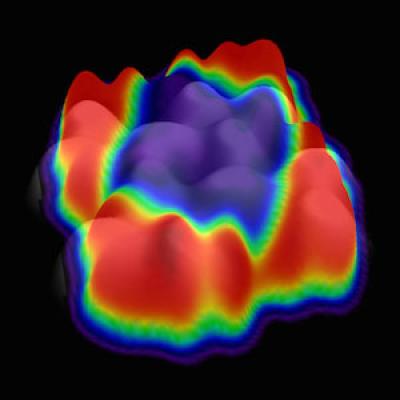Organic semiconductors get weird at the edge: University of British Columbia research

This composite image shows the difference in electronic states at the edge of the material compared to molecules in the centre. Credit: University of British Columbia
The work, published this week in Nature Communications, details how electronic properties at the edges of organic molecular systems differ from the rest of the material.
Organic materials–plastics–are of great interest for use in solar panels, light emitting diodes and transistors. They're low-cost, light, and take less energy to produce than silicon. Interfaces–where one type of material meets another–play a key role in the functionality of all these devices.
“We found that the polarization-induced energy level shifts from the edge of these materials to the interior are significant, and can't be neglected when designing components,” says UBC PhD researcher Katherine Cochrane, lead author of the paper.
'While we were expecting some differences, we were surprised by the size of the effect and that it occurred on the scale of a single molecule,” adds UBC researcher Sarah Burke, an expert on nanoscale electronic and optoelectronic materials and author on the paper.
The researchers looked at 'nano-islands' of clustered organic molecules. The molecules were deposited on a silver crystal coated with an ultra-thin layer of salt only two atoms deep. The salt is an insulator and prevents electrons in the organic molecules from interacting with those in the silver–the researchers wanted to isolate the interactions of the molecules.
Not only did the molecules at the edge of the nano-islands have very different properties than in the middle, the variation in properties depended on the position and orientation of other molecules nearby.
The researchers, part of UBC's Quantum Matter Institute, used a simple, analytical model to explain the differences which can be extended to predict interface properties in much more complex systems, like those encountered in a real device.
“Herbert Kroemer said in his Nobel Lecture that 'The interface is the device' and it's equally true for organic materials,” says Burke. “The differences we've seen at the edges of molecular clusters highlights one effect that we'll need to consider as we design new materials for these devices, but likely they are many more surprises waiting to be discovered.”
Cochrane and colleagues plan to keep looking at what happens at interfaces in these materials and to work with materials chemists to guide the design rules for the structure and electronic properties of future devices.
Methods
The experiment was performed at UBC's state-of-the-art Laboratory for Atomic Imaging Research, which features three specially designed ultra-quiet rooms that allow the instruments to sit in complete silence, totally still, to perform their delicate measurements. This allowed the researchers to take dense data sets with a tool called a scanning tunnelling microscope (STM) that showed them the energy levels in real-space on the scale of single atoms.
Media Contact
All latest news from the category: Materials Sciences
Materials management deals with the research, development, manufacturing and processing of raw and industrial materials. Key aspects here are biological and medical issues, which play an increasingly important role in this field.
innovations-report offers in-depth articles related to the development and application of materials and the structure and properties of new materials.
Newest articles

NASA: Mystery of life’s handedness deepens
The mystery of why life uses molecules with specific orientations has deepened with a NASA-funded discovery that RNA — a key molecule thought to have potentially held the instructions for…

What are the effects of historic lithium mining on water quality?
Study reveals low levels of common contaminants but high levels of other elements in waters associated with an abandoned lithium mine. Lithium ore and mining waste from a historic lithium…

Quantum-inspired design boosts efficiency of heat-to-electricity conversion
Rice engineers take unconventional route to improving thermophotovoltaic systems. Researchers at Rice University have found a new way to improve a key element of thermophotovoltaic (TPV) systems, which convert heat…



